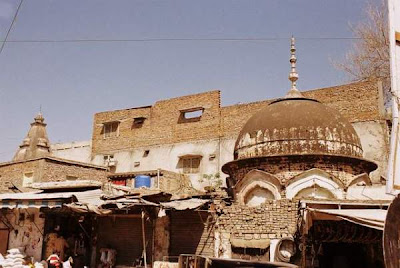 |
Ambardaran mandir, Bohar Bazaar. All Photographs by Shiraz Hassan |
In the early 19th century, the British made Rawalpindi the central seat of military power as they aimed towards Afghanistan. This was in line with their strategic approach towards the Russian Empire in order to enjoy and retain complete control over central Asia. Known as the Great Game, the conflict continues today in another form.
 |
In Chungi no. 4 |
After the Partition in 1947, Rawalpindi continued to be the General Headquarters of the Army. But Pindi has a lot more to tell than just martial tales. The city has been known for its heritage and culture. Its multi-religious character changed when almost all of its Hindu and Sikh inhabitants left for India. Sixty five years after the Partition, I went looking for their temples and Gurudwaras.
 |
A temple in Chungi no. 4 |
Walking around the old city, in areas like Krishanpura, Akaal Garh, Mohanpura, Amarpura, Kartarpura, Bagh Sardaraan, Angatpura, you can see Pindi’s heritage. There are about ten temples and Gurudwaras which are no longer functional and are in a very bad shape. One temple located at Kohati Bazaar is in good condition. Its premises are used as a government school for disabled children. Another beautiful Gurdwara known as Bagh Sardaraan is used by the Punjab Police as their main office.
 |
| A detail in a temple in Ganjmandi |
The temple located at Govt. Asghar Mall College is used as a scrapyard. A Shiva temple at Gunjmandi now houses storerooms or shops. There are some more abandoned temples scattered around College Road, Bohar Bazaar, Purana Qilla, Bagh Sardaraan and then some outskirts of Rawalpindi which are on the verge of collapse.
 |
| In Ganjmandi |
In the old area of Lunda Bazaar, there used to be three temples, a Gurdwara, a Khalsa School and many Havelis of Hindus and Sikhs. Of the three temples, two have survived. The third, of goddess Kali in the main bazaar, no longer exists. It has been converted into living quarters and extensions have been made, thus changing the original structure entirely. In Lunda bazaar there is a tall structure of a temple known as Mohan Mandir. This temple is believed to have been built by two Hindu Hakims in 1930, Hakim Asa Anand and Hakim Moti Ram.
 |
| In Ganjmandi |
It is sad that even though there are so many abandoned temples in Rawalpindi and Islamabad, there is not a single place for the Hindus living in the twin cities to celebrate their festivals like Diwali, Shivratri or Holi. There are more than 25,000 Hindus living in Rawalpindi and Islamabad. Some of them have migrated from other parts of Pakistan, mainly the Sindh province.
 |
| The entry to a temple in Gunjmandi. |
Recently, following a request from Ramesh Lal, a Hindu parliamentarian of the ruling Pakistan People’s Party, Prime Minister Raja Pervez issued a directive to the chairman of the Capital Development Authority to build a new temple for the Hindu community. That is no doubt a good gesture but the government must also urgently restore and preserve the old heritage of the city.
 |
| In Ganjmandi |
 |
| Gurdwara Bagh Sardaraan |
 |
| Mohan mandir at Lunda Bazaar |
 |
| A detail in Mohan mandir, Lunda Bazaar |
 |
| In Purana Qilla area |
 |
| In Bagh Sardaraan |
 |
| In Sagri village, Rawalpindi |
 |
| A temple near Rawal lake in Islamabad |
 |
| A temple near Rawal lake in Islamabad |
 |
| Twin temples in Sagri village, Rawalpindi |
 |
| In Purana Qilla area, Rawalpindi |
This post was originally published at
KafilaTweet
Shiraz Hassan is a magazine reporter and feature writer for Sunday Magazine in Lahore, Pakistan, where he covers social issues, art and culture. At the magazine, he has published more than 400 features related to social problems, culture and ‘show biz.’ Shiraz has also worked as a news editor at the radio network “MAST FM 103” in Lahore.
He writes about culture and heritage of South Asia, particularly Pakistan. He advocates rich culture of this land and tries to explore facts. Recently he was given an award from the Federal Ministry of Population Welfare for his article on population crises. Writers Guild also awarded him a Medal of excellence for his work.



























